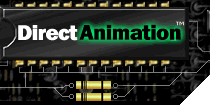



Index
Topic Contents
Previous Topic: How to Create a VBScript Animation
Next Topic: How to Write a DirectAnimation Java Applet
 |
 | 
|

|
| |||
| |||
How to Build a DirectAnimation Java Applet or Application
This section discusses three methods you can use to build a DirectAnimation Java applet or application.
In Microsoft Visual J++™:
- From the File menu, choose New.
- From the dialog box that appears, choose the Projects tab.
- Select Java Project as the project type, type a name into the Project name text box, type a path into the Location text box, and then click OK. The Java project is created.
- From the Project menu, choose Add To Project, and then choose Files from the submenu that appears.
- In the Insert Files into Project dialog box that appears, browse for your .java files, select the files you want to add, and then click OK.
- From the Build menu, choose Build MyApp where MyApp is your project's name. The .class files are built, and a test HTML file is generated automatically.
With the Jvc compiler from the command line:
The Jvc.exe Java compiler is delivered with Visual J++ and the Microsoft SDK for Java.
- Set your environment path to include the location of Jvc.exe. For example:
set path=c:\"program files"\devstudio\sharedide\binor:
set path=c:\java\sdk\bin- Go to the directory containing the .java files.
- At the command line prompt, type:
jvc *.javaThe class files will be generated. No test HTML will be generated.
With NMAKE and a sample or template makefile
- Set your environment path to include the location of NMAKE.exe. For example:
set path=c:\"program files"\devstudio\vc\bin- Set your environment path to include the location of Jvc.exe. For example:
set path=c:\"program files"\devstudio\sharedide\bin- Go to the directory containing the makefile.
- At the command line prompt, type:
NMAKE© 1998 Microsoft Corporation. All rights reserved. Terms of Use.